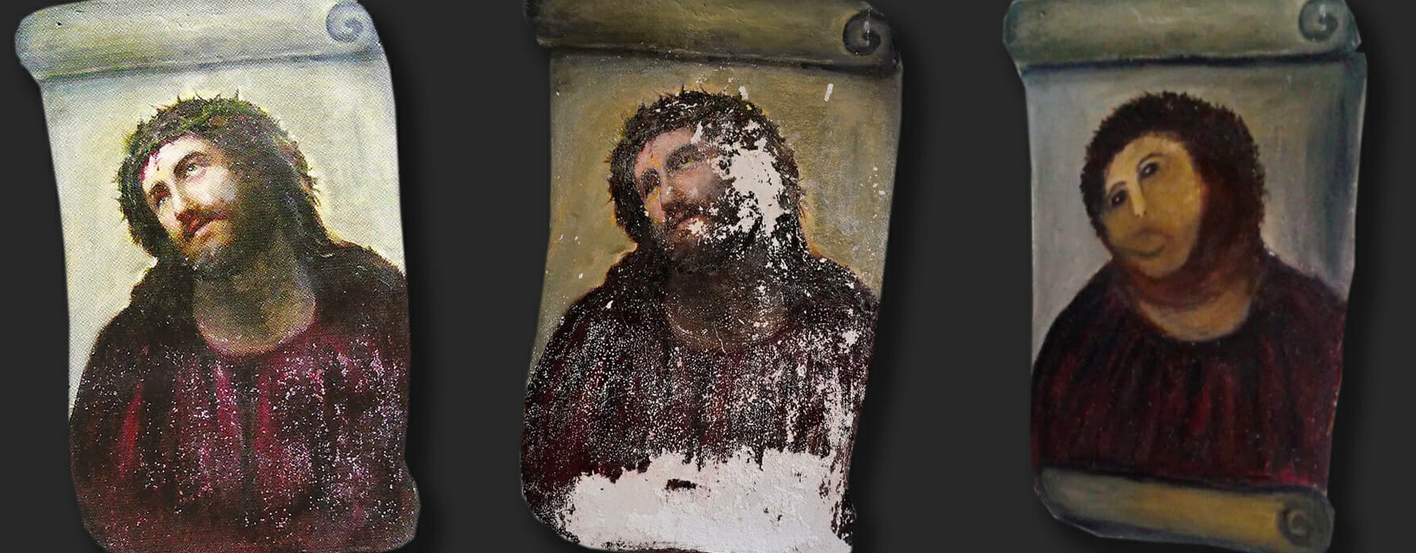
An image which may or may not be related to the article. FREEPIK
Art Restoration Gone Wrong: When Fixing Art Destroys It
Summary:
Art restoration is supposed to be a delicate process—a skilled hand bringing faded masterpieces back to life. But sometimes, those hands slip, and instead of preservation, we get absolute carnage. From the infamous “Monkey Jesus” to the tragic destruction of irreplaceable frescoes, history is littered with well-intentioned disasters that make the art world scream in horror. What happens when the saviors of art become its executioners? Let’s take a look at the restorations that went terribly, hilariously, and heartbreakingly wrong.
Enter the restorers. A secretive breed of meticulous experts, armed with the finest brushes, the steadiest hands, and the weight of entire civilizations resting on their shoulders. Their job is to preserve history, to breathe life back into paintings and statues long after their creators have turned to dust. It is an art form in itself.
And sometimes, it is an absolute disaster.
Because for every carefully executed restoration, there is one that goes spectacularly, mind-bendingly, eye-wateringly wrong. A single miscalculation, a poor choice of materials, an overzealous hand—and suddenly, you’re not reviving Michelangelo. You’re giving Jesus a monkey face.
The Crimes Against Canvas
You can hear the screams of art historians echo through the halls of museums whenever a restoration fails. And for good reason—some of these blunders are so catastrophically bad that they cross the line from tragedy to unintentional comedy.
Take Ecce Homo, a 19th-century fresco in a small Spanish church. It was a perfectly respectable, if slightly worn, depiction of Christ—until a well-meaning but utterly unqualified elderly parishioner decided to “fix” it. Armed with little more than divine inspiration and what one can only assume was a dollar-store paintbrush, she turned a fading masterpiece into a lumpy, bewildered figure that looked more like an ape than the son of God.
The result? Internet infamy. The “Monkey Jesus” meme was born, and tourists flocked to see the disaster in person. It became a kind of accidental modern masterpiece—a cautionary tale wrapped in viral hilarity.
And that wasn’t the only one. Spain, for reasons unknown, seems to be a hotspot for restoration crimes. In 2020, an amateur attempt to clean up a centuries-old sculpture of the Virgin Mary resulted in her looking more like a cartoon character than a religious icon. The same year, a botched restoration of The Immaculate Conception left the Virgin Mary’s face unrecognizable, her once-serene expression replaced with something that looked like a melting wax figure.
It’s a fine line between artistic salvation and vandalism, and in these cases, that line was not just crossed—it was obliterated.
Too Much of a Good Thing
But not all art restoration disasters are the result of enthusiastic amateurs. Sometimes, the professionals themselves push too far.
One of the most infamous examples? The Sistine Chapel. Yes, that Sistine Chapel.
In the 1980s and 90s, a massive restoration effort set out to clean Michelangelo’s breathtaking frescoes, which had darkened under centuries of grime, candle soot, and neglect. The restorers stripped away layer upon layer, revealing shockingly vivid colors—so vivid, in fact, that some art historians were horrified.
Had they gone too far? Had centuries of delicate shading and artistic subtlety been scrubbed away in the pursuit of brightness? The debate still rages on.
Then there’s the case of Leonardo da Vinci’s The Last Supper. In an effort to preserve the fragile mural, multiple restorations over the centuries ended up damaging it even more, layering on so much repainting and overcorrection that very little of Leonardo’s original brushwork remains today.
Sometimes, the road to hell is paved with good intentions—and a little too much solvent.
Why Do These Disasters Keep Happening?
The terrifying truth? Most of the world’s great artworks are deteriorating as we speak. Museums and churches are filled with masterpieces barely holding themselves together, and someone—qualified or not—is going to have to deal with them.
And with that comes a few unfortunate realities:
- Desperation: Some restoration attempts happen because the artwork is on the verge of total ruin. It’s a last-ditch effort, and sometimes, things go south.
- Money Problems: Proper restoration is expensive. When budgets are tight, desperate institutions may cut corners—or worse, hand the job to someone who has no business being near a paintbrush.
- Ego: Some restorers see themselves as artists in their own right, eager to leave their mark. The problem? Their mark might not match what history had in mind.
Restoration, when done right, is a miracle. When done wrong, it’s destruction masquerading as preservation.
The Fine Line Between Saving and Ruining Art
So where does this leave us? Do we stop trying to fix what time erodes? Do we accept that some things are meant to fade?
It’s a delicate balance. Without restoration, we lose history. But with reckless restoration, we risk turning masterpieces into laughingstocks.
One can only hope that future restorers will take these past disasters as warnings. Because while art is meant to last forever, one bad brushstroke can turn eternity into a punchline.
 muppazine
muppazine